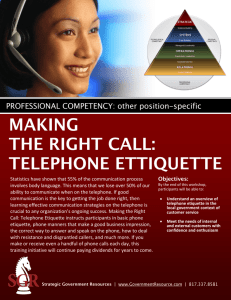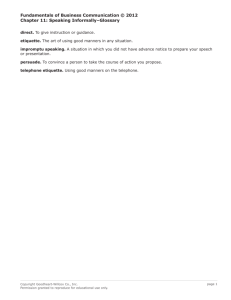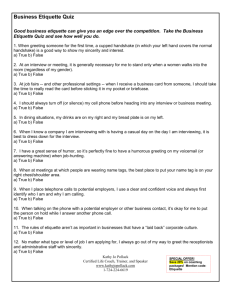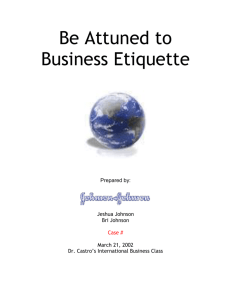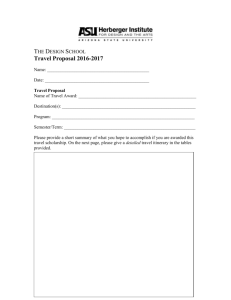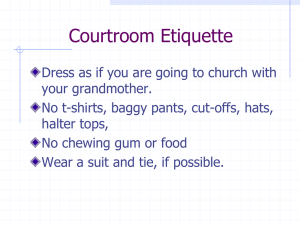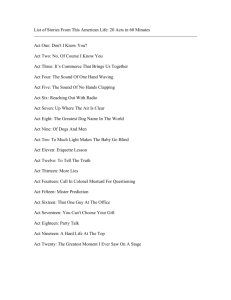International Business Etiquette
advertisement
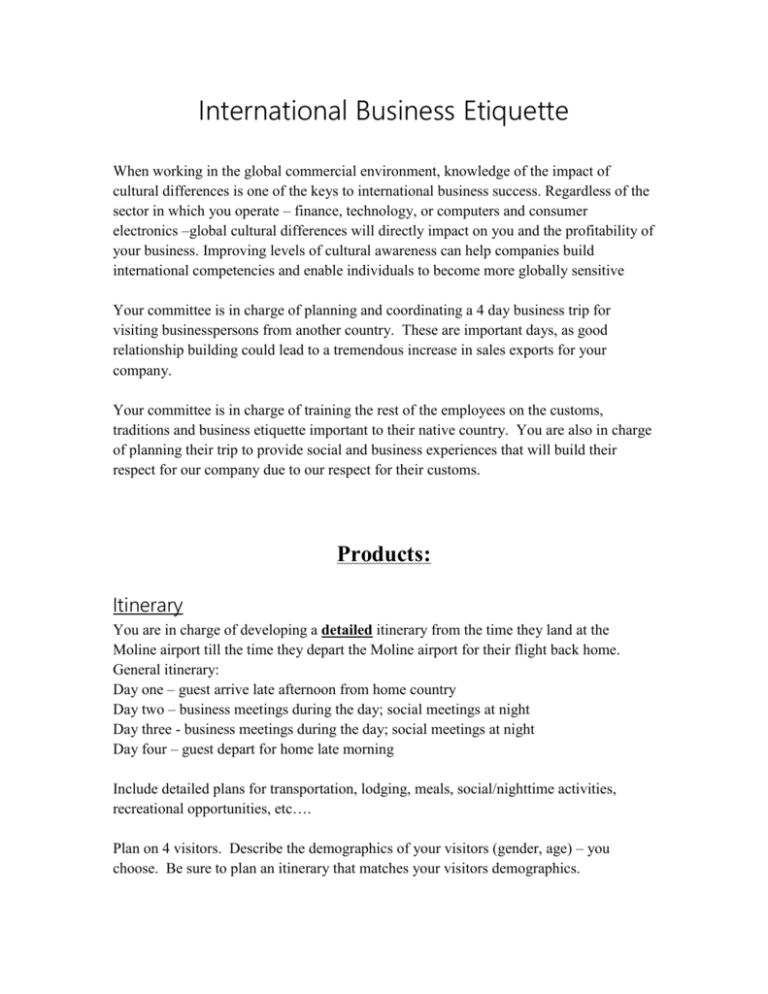
International Business Etiquette When working in the global commercial environment, knowledge of the impact of cultural differences is one of the keys to international business success. Regardless of the sector in which you operate – finance, technology, or computers and consumer electronics –global cultural differences will directly impact on you and the profitability of your business. Improving levels of cultural awareness can help companies build international competencies and enable individuals to become more globally sensitive Your committee is in charge of planning and coordinating a 4 day business trip for visiting businesspersons from another country. These are important days, as good relationship building could lead to a tremendous increase in sales exports for your company. Your committee is in charge of training the rest of the employees on the customs, traditions and business etiquette important to their native country. You are also in charge of planning their trip to provide social and business experiences that will build their respect for our company due to our respect for their customs. Products: Itinerary You are in charge of developing a detailed itinerary from the time they land at the Moline airport till the time they depart the Moline airport for their flight back home. General itinerary: Day one – guest arrive late afternoon from home country Day two – business meetings during the day; social meetings at night Day three - business meetings during the day; social meetings at night Day four – guest depart for home late morning Include detailed plans for transportation, lodging, meals, social/nighttime activities, recreational opportunities, etc…. Plan on 4 visitors. Describe the demographics of your visitors (gender, age) – you choose. Be sure to plan an itinerary that matches your visitors demographics. In your presentation you will describe your business, the visitors business and how your 2 businesses may work together. In your itinerary, be sure to include “business” meetings and functions that are appropriate as well. Top Tips cheat sheet The cheat sheet will be given to the rest of the employees at your company to utilize when our visitors arrive. It should contain a summary of the most important customs, traditions, and etiquette items that employees need to remember when interacting with people from your foreign country. This can be formatted as a 1-page handout, brochure, etc…; but it should be produced in a professional, easy-to-read, easy-to-use guide. Presentation/training Your committee will be conducting a training program for the rest of the employees in the company (your classmates). Your goal is to train the rest of the company on the customs, traditions, and etiquette of your foreign country. Not only will these businesspersons be visiting you, but you and others from your business will be traveling to their country soon. Your goal is to engage the rest of the employees in learning and utilize as many senses as possible. Here is an outline of the potential methods you could utilize to engage your audience. See Rubric for more details. 1. 2. 3. 4. 5. 6. 7. 8. Presentation – PowerPoint, Prezi, etc… Video – embedded in presentation or stand-alone Photos - embedded in presentation or stand-alone Music/language - embedded in presentation or stand-alone Venn Diagram Chart (compare and contrast) Demonstrations – ex. Greetings, personal space, etc… Food/Dress – sample of typical food from that country or typical clothing Native guest speaker (in person, skype, recorded) Assessment Create an assessment worth 10 points that will be given to the rest of the employees after your presentation to assess how much they learned from your training. Potential Research Topics General Information: People General attitudes Gestures Housing Allies Holidays Transportation Flag Language Personal Appearance Eating Dating and Marriage Recreation Government Education Famous People Religion Greetings Family Life Cycle The Arts Economy Health Map-location Business Etiquette, Manners and Customs Meeting Etiquette Dining Etiquette Business meeting etiquette Names Non-verbal communication Eye contact Dress Titles Negotiations Gift giving Communication style Personal space & touching Gestures Taboos Socializing Table manners Introductions Time Business Cards Greetings Gender issues Law and order US Relations Overview Major areas of cooperation Trade and Economic Relations Important statistics and demographics – Graphs/Charts/tables – comparison to US (and others) Capital Leaders Currency Population/Age Economy Literacy Underweight children Mortality rates Life expectancy Doctors Energy Potential Resources Culture gram – AEA - www.iowaaeaonline.org Central HS: login 1082cenhs password: mbaea9 Embassy website Government website Country Profiles – global guide to culture, customs and etiquette http://www.kwintessential.co.uk/resources/country-profiles.html International Business Etiquette, Manners, and Culture http://www.cyborlink.com/besite/ World Business Cultures http://www.worldbusinessculture.com/ Ask an Expert? Do business abroad. http://www.culturecrossing.net/ask_an_expert.php Connect w/Community http://www.culturecrossing.net/connect_comm.php Culture Crossing – Community Guide http://www.culturecrossing.net/index.php Tentative Timeline 11/26 – Introduction, Form Groups, Committee/Group planning “how-to”, Choose your country, Begin developing a Plan of Action chart, Start Research 11/28 – Continue Research, Plan of Action (POA) Chart due 11/30 – Continue Research, Product Development, POA progress report due end of day 12/4 – Product Development (potential guest speaker-45 minutes) 12/6 – Product Development, Presentation Planning 12/10 – Finalize Product Development, POA progress report due end of day 12/12 – (early dismissal) – Final preparations and practice for presentations, ALL “products” due end of the day 12/14 – Presentations Groups 1-3 12/18 – Presentations Groups 4-6 Assessment Itinerary 20% Top Tips cheat sheet 10% Presentation/Training 50% Assessment Group evaluation 5% 15%
